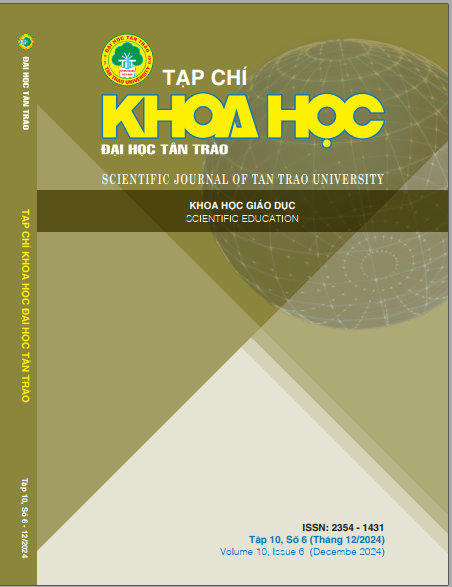APPLYING THE SHADOWING TECHNIQUE TO ENHANCE SPEAKING PROFICIENCY AMONG ENGLISH MAJORS: OBSTACLES AND REMEDIES
DOI:
https://doi.org/10.51453/2354-1431/2024/1221Keywords:
Shadowing technique, speaking skills, English, obstacles, remediesAbstract
This research examines the efficacy of the shadowing strategy in enhancing speaking proficiency among third-year English majors at Hanoi Metropolitan University. The study utilized a mixed-methods approach, including quantitative surveys and qualitative interviews, to emphasize students' confidence, fluency, and pronunciation. Results indicate that although the majority of participants exhibited enhancements in fluency and pronunciation, difficulties remain. Primary challenges encompass restricted access to suitable resources, cognitive stress, and the struggle to keep a regular practice regimen. Furthermore, students underscored the necessity of consistent feedback to evaluate progress and target certain areas for enhancement. The difficulty of aligning with the natural tempo of native speakers frequently resulted in dissatisfaction and diminished motivation. In light of these findings, we advocate for organized, supervised shadowing sessions, the supply of varied, interest-aligned resources, and a comprehensive feedback mechanism. Customizing shadowing resources for varying competence levels and including other activities, such as role-playing, may further augment language acquisition. This study highlights the significance of organized support in optimizing the effectiveness of shadowing for enhancing speaking proficiency.
Downloads
References
Cherry, E. C. (1953). Some experiments on the recognition of speech, with one and with two ears. Journal of the Acoustical Society of America, 25(5), 975–979. https://doi.org/10.1121/1.1907229
Hamada, Y. (2019). The impact of different types of shadowing training on Japanese learners’ listening and speaking proficiency. Applied Linguistics Review, 10(2), 193–217. https://doi.org/10.1515/applirev-2017-0117
Hoang, V. (2019). The application of shadowing in improving English pronunciation for Vietnamese learners. Journal of Language Education and Research, 5(2), 45–55.
Kadota, S., & Tamai, K. (2004). English shadowing training: Speech, brain, and listening comprehension. Cosmopier Publishing.
Li, S. (2018). A meta-analysis of the effectiveness of shadowing in improving second language learners’ listening and speaking skills. Language Learning, 68(1), 195–223. https://doi.org/10.1111/lang.12267
Minh, L. (2023). Obstacles in applying shadowing techniques among Vietnamese university students. Vietnam Journal of Educational Research, 29(3), 134–145.
Murphey, T. (1995). Shadowing in language learning: Benefits and challenges. Language Teaching Publications.
Ngoc, L. P. (2018). Common pronunciation errors in English by Vietnamese learners and the role of shadowing in improvement. Journal of Linguistics and Language Teaching, 3(1), 11–22.
Saito, K. (2013). Re-examining effects of form-focused instruction on L2 pronunciation development. Studies in Second Language Acquisition, 35(1), 1–29. https://doi.org/10.1017/S0272263112000666
Shiki, O., Mori, Y., Kadota, S., & Yoshida, S. (2010). Shadowing as a listening exercise: The effects of oral repetition on L2 listening comprehension. The Language Teacher, 34(5), 3–10.
Tam, T. T. T. (2022). Shadowing technique in preparation for language proficiency tests among Vietnamese learners. Vietnam Journal of Applied Linguistics, 8(4), 142–153.
Thu, T. N. (2021). Shadowing technique in the Vietnamese EFL context: Benefits and challenges. Vietnamese Journal of Foreign Language Education, 19(2), 87–96.
Thu, N. T., Lan, M. T., & Nam, H. P. (2020). Improving English fluency in Vietnamese students through shadowing techniques. Vietnamese Journal of English Language Teaching, 22(1), 25–34.
Yamashita, T., & Ichikawa, S. (2021). Shadowing and dictogloss as strategies for reducing cognitive overload in language learning. International Journal of Educational Research, 105. https://doi.org/10.1016/j.ijer.2021.101692
Downloads
Published
How to Cite
Issue
Section
License

This work is licensed under a Creative Commons Attribution-ShareAlike 4.0 International License.
All articles published in SJTTU are licensed under a Creative Commons Attribution-ShareAlike 4.0 International (CC BY-SA) license. This means anyone is free to copy, transform, or redistribute articles for any lawful purpose in any medium, provided they give appropriate attribution to the original author(s) and SJTTU, link to the license, indicate if changes were made, and redistribute any derivative work under the same license.
Copyright on articles is retained by the respective author(s), without restrictions. A non-exclusive license is granted to SJTTU to publish the article and identify itself as its original publisher, along with the commercial right to include the article in a hardcopy issue for sale to libraries and individuals.
Although the conditions of the CC BY-SA license don't apply to authors (as the copyright holder of your article, you have no restrictions on your rights), by submitting to SJTTU, authors recognize the rights of readers, and must grant any third party the right to use their article to the extent provided by the license.


